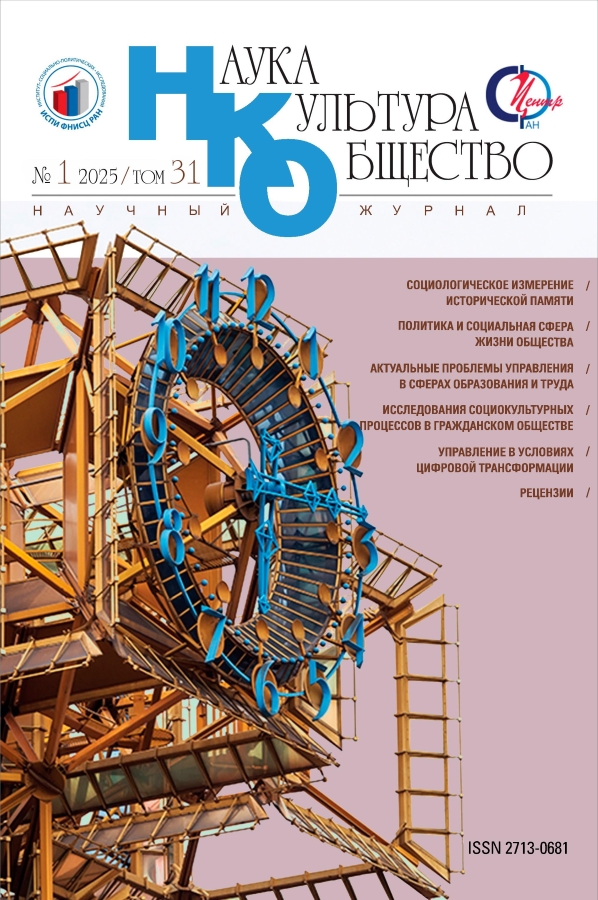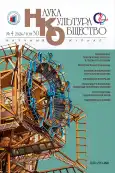Комедийные стили в медиа-форматах разных поколений (на примере Филиппин)
- Авторы: Велес Д.А.1, Салдуа Л.К.1, Морено А.Ш.1, Сантандер Э.Э.1, Гамос В.Э.1
-
Учреждения:
- Университет Ксавье – Атенео де Кагаян
- Выпуск: Том 30, № 4 (2024)
- Страницы: 134-149
- Раздел: ГЛОБАЛЬНЫЕ И ЛОКАЛЬНЫЕ ТЕНДЕНЦИИ КУЛЬТУРНОГО РАЗВИТИЯ
- URL: https://journal-vniispk.ru/2713-0681/article/view/276765
- DOI: https://doi.org/10.19181/nko.2024.30.4.9
- EDN: https://elibrary.ru/BQMFZX
- ID: 276765
Цитировать
Полный текст
Аннотация
Ключевые слова
Об авторах
Дон Антонио Велес
Университет Ксавье – Атенео де Кагаян
Email: dvelez@xu.edu.ph
ORCID iD: 0000-0002-0089-5954
доцент, департамент социологии и антропологии; PhD Soc, колледж искусств и наук Кагаян-де-Оро, Филиппины
Лоренц Кристиан Салдуа
Университет Ксавье – Атенео де Кагаян
Email: dvelez@xu.edu.ph
студент программы бакалавриата искусств в области междисциплинарных исследований, колледж искусств и наук Кагаян-де-Оро, Филиппины
Алиса Шанталь Морено
Университет Ксавье – Атенео де Кагаян
Email: dvelez@xu.edu.ph
студент программы бакалавриата искусств в области междисциплинарных исследований, колледж искусств и наук Кагаян-де-Оро, Филиппины
Элла Эрика Сантандер
Университет Ксавье – Атенео де Кагаян
Email: dvelez@xu.edu.ph
студент программы бакалавриата искусств в области междисциплинарных исследований, колледж искусств и наук Кагаян-де-Оро, Филиппины
Винсент Эйрод Гамос
Университет Ксавье – Атенео де Кагаян
Email: dvelez@xu.edu.ph
студент программы бакалавриата искусств в области междисциплинарных исследований, колледж искусств и наук Кагаян-де-Оро, Филиппины
Список литературы
- McCrindle M. Word up: A Lexicon and guide to communication in the 21st century. Sydney: Halstead Press; 2010. ISBN 9781920831851.
- Meaney J. A. Crossing the line: Where do demographic variables fit into humor detection? In: Proceedings of the 58th Annual Meeting of the Association for Computational Linguistics. Stroudsburg: Association for Computational Linguistics; 2020. P. 176–181.
- Kingstone H. Generational identities: Historical and literary perspectives. Social and Personality Psychology Compass. 2021;15(10):e12641. doi: 10.1111/spc3.12641. EDN WULEGJ.
- Chanos G. J. Millennial Samurai: A mindset for the 21st century. Independently Publ.; 2020. ISBN: 978-1688563339.
- Salvosa H. C., Hechanova M. R. Generational differences and implicit leadership schemas in the Philippine workforce. Leadership & Organization Development Journal. 2021;42(1):47–60. doi: 10.1108/LODJ-08-2018-0314.
- Lüders M. Conceptualizing personal media. New Media & Society. 2008;10(5):683–702. doi: 10.1177/1461444808094352.
- Thompson J. B. Ideology and modern culture: Critical social theory in the era of mass communication. Cambridge: Polity Press; 2013.
- Дмитриев А. В. Социология политического юмора М. РОССПЭН, 1998. 332 с. URL: https://djvu.online/file/GcbeRvFo9h5re (accessed: 09.07.2024).
- Astapova A. Why all dictators have moustaches: Political jokes in contemporary Belarus. Humor. 2015;28(1):71–91. doi: 10.1515/humor-2014-0142.
- Becker A. B., Haller B. A. When political comedy turns personal: humor types, audience evaluations, and attitudes. Howard Journal of Communications. 2014;25(1):34–55. doi: 10.1080/10646175.2013.835607.
- Boukes M., Hameleers M. Shattering populists' rhetoric with satire at elections times: The effect of humorously holding populists accountable for their lack of solutions. Journal of Communication. 2020;70(4):574–597. doi: 10.1093/joc/jqaa020.
- Burgers C., Brugman B. C. How satirical news impacts affective responses, learning, and persuasion: A three-level random-effects meta-analysis. Communication Research. 2022;29(7):966–993. doi: 10.1177/00936502211032100. EDN SPZUJT.
- Brok A. Modelling the complexity of humour – Insights from linguistics. Lingua. 2017;197:5–15. doi: 10.1016/j.lingua.2017.04.008.
- Dynel M. But seriously: On conversational humour and (un)truthfulness. Lingua. 2017;197:83–102. doi: 10.1016/j.lingua.2017.05.004.
- McBride S. K., Ball J. #TheSmoreYouKnow and #emergencycute: A conceptual model on the use of humor by science agencies during crisis to create connection, empathy, and compassion. International Journal of Disaster Risk Reduction. 2022.77:102995. doi: 10.1016/j.ijdrr.2022.102995. EDN NJFSKA.
- Borum C. The revolution will be hilarious: Comedy for social change and civic power. NYU Press; 2023. ISBN: 978-1479810833.
- Davies C. E. An autoethnographic approach to understanding identity construction through the enactment of sense of humor as embodied practice. Journal of Pragmatics. 2019;152:200–215. doi: 10.1016/j.pragma.2019.02.010.
- Plessen C. Y., Franken F. R., Ster C. [et al.]. Humor styles and personality: A systematic review and meta-analysis on the relations between humor styles and the Big Five personality traits. Personality and Individual Differences. 2020;154:109676. doi: 10.1016/j.paid.2019.109676. EDN TAIDPS.
- Hirsch G. Humor appreciation in the digital era. Lingua. 2017;197:123–140. doi: 10.1016/j.lingua.2017.06.016.
- Berger A. A. Humor, psyche, and society: A socio-semiotic analysis. Vernon Press; 2020. ISBN: 978-1622738083.
- Gournelos T., Greene V. (eds.). A decade of dark humor: How comedy, irony, and satire shaped post-9/11 America. Jackson: University Press of Mississippi; 2011. ISBN: 978-1617038235.
- Veale T., Valitutti A. Tweet dreams are made of this: Appropriate incongruity in the dreamwork of language. Lingua. 2017;197:141–153. doi: 10.1016/j.lingua.2017.07.004.
- Heintz S., Ruch W. From four to nine styles: An update on individual differences in humor. Personality and Individual Differences. 2019;141:7–12. doi: 10.1016/j.paid.2018.12.008.
- Vrabel J. K., Zeigler-Hill V., Shango R. G. Spitefulness and humor styles. Personality and Individual Differences. 2017;105:238–243. doi: 10.1016/j.paid.2016.10.001.
- Wei H., Shan D., Wang L., Zhu S. Research on the mechanism of leader aggressive humor on employee silence: A conditional process model. Journal of Vocational Behavior. 2022;135:103717. doi: 10.1016/j.jvb.2022.103717. EDN YGXUIL.
- Jach L., Kubicius D., Jonason P. K. “Do they fit together like the Joker and Harley Quinn?”: Joking, laughing, humor styles, and dyadic adjustment among people in long-term romantic relationships. Personality and Individual Differences. 2022;199:111859. doi: 10.1016/j.paid.2022.111859. EDN GVEJLR.
- Wu C.-L., Lin H.-Y., Chen H.-C. Gender differences in humour styles of young adolescents: Empathy as a mediator. Personality and Individual Differences. 2016;99:139–143. doi: 10.1016/j.paid.2016.05.018.
- Yamane H., Mori Y., Harada T. Humor meets morality: Joke generation based on moral judgement. Information Processing & Management. 2021;58(3):102520. doi: 10.1016/j.ipm.2021.102520. EDN EWFPBU.
- De Ridder A., Vandebosch H., Dhoest A. Examining the hedonic and eudaimonic entertainment experiences of the combination of stand-up comedy and human-interest. Poetics. 2022;90(4):101601. doi: 10.1016/j.poetic.2021.101601. EDN BJJDMV.
- Lederer P. S. Mike Nichols. Elaine May, Mel Brooks, and Woody Allen's "New Cabaret": Underground Jewish humor and the evolution of the new Hollywood aesthetic. Doctoral dissertation, Queen's University Belfast. 2021.
- Iglikova R. Translation techniques in Walt Disney animation studios feature film titles – a comparative study of Bulgarian and Russian translations. Knowledge – International Journal. 2023;61(5):955–960.
- Ayling K., Brown M., Carlisle S. [et al.]. Optimizing mood prior to influenza vaccination in older adults: A three-arm randomized controlled trial. Health Psychology. 2024;43(2):77–88. doi: 10.1037/hea0001267. EDN RFNMUT.
- Green B. R. The artist's code: Technology and the optimization of creativity in Hollywood. Los Angeles: University of California; 2023.
- Balmores-Paulino R. S. An exploration of the schema and function of humor. Israeli Journal for Humor Research. 2018;7(2):43–63.
- Dionigi A., Duradoni M., Vagnoli L. Humor and anxiety: The relationship between the comic styles, worry and general well-being. Personality and Individual Differences. 2021;181(4):111028. doi: 10.1016/j.paid.2021.111028. EDN MTNHU.
- Kfrerer M. L., Bell E., Schermer J. A. The politics of being funny: Humor styles, trait humorousness, and political orientations. Personality and Individual Differences. 2021;182:111073. doi: 10.1016/j.paid.2021.111073. EDN AIULXO.
- Stoltzfus-Brown L. Mapping myriad positionalities in Amish media studies. Journal of Amish and Plain Anabaptist Studies. 2020;8(1):65–74.
- Dynel M., Chovanec J. Creating and sharing public humour across traditional and new media. Journal of Pragmatics. 2021;177:151–156. doi: 10.1016/j.pragma.2021.02.020. EDN RYMQKC.
- Keeton B. J. What is a podcast? A brief history, how to listen to them, and how to create them. Elegant themes; 2020. Available at: https://www.elegantthemes.com/blog/marketing/what-is-a-podcast-a-brief-history-how-to-listen-to-them-and-how-to-create-them (accessed: 09.07.2024).
- Hussein A. T., Aljamili L. N. COVID-19 humor in Jordanian social media: A socio-semiotic approach. Heliyon. 2020;6(12):e05696. doi: 10.1016/j.heliyon.2020.e05696.
- Vásquez C., Aslan E. “Cats be outside, how about meow”: Multimodal humor and creativity in an internet meme. Journal of Pragmatics. 2021;171:101–117. doi: 10.1016/j.pragma.2020.10.006. EDN HZMIJB.
- Facchinetti R. News discourse and the dissemination of knowledge and perspective: From print and monomodal to digital and multisemiotic. Journal of Pragmatics. 2021;175:195–206. doi: 10.1016/j.pragma.2021.01.015. EDN AHYIGB.
- Jiang T., Li H., Hou Y. Cultural differences in humor perception, usage, and implications. Frontiers in psychology. 2019;10:123. doi: 10.3389/fpsyg.2019.00123.
- Hoffmann S., Schwarz U., Dalicho L., Hutter K. Humor in cross-cultural advertising: A content analysis and test of effectiveness in German and Spanish print advertisements. Procedia – Social and Behavioral Sciences. 2014;148:94–101. doi: 10.1016/j.sbspro.2014.07.022.
- Dimitrieska S., Koneska L., Kozareva K. G., Teofilovska J. The power of private brands. CBU International Conference Proceedings. 2017;5:114–119. doi: 10.12955/cbup.v5.911.
- Speck P. S., Schumann D. W., Thompson C. Celebrity endorsements-scripts, schema and roles: Theoretical framework and preliminary tests. Advances in consumer research. 1988;15(1):69–76.
- Catanescu C., Tom G. Types of humor in television and magazine advertising. Review of business. 2001;22:92–95.
- Hoang H., Antoncic B. Network-based research in entrepreneurship: A critical review. Journal of business venturing. 2003;18(2):165–187. doi: 10.1016/S0883-9026(02)00081-2. EDN BGEOJP.
- Meng R., Shen X. Research on fonts in the design of movie posters. In: 7th International Conference on Arts, Design and Contemporary Education (ICADCE 2021). Atlantis Press; 2021. P. 331–334. doi: 10.2991/assehr.k.210813.057.
- Wang Y. Humor and camera view on mobile short-form video apps influence user experience and technology-adoption intent, an example of TikTok (DouYin). Computers in Human Behavior. 2020;110:106373. doi: 10.1016/j.chb.2020.106373.
- Bakar F., Kumar V. The use of humour in teaching and learning in higher education classrooms: Lecturers’ perspectives. Journal of English for Academic Purposes. 2019;40:15–25. doi: 10.1016/j.jeap.2019.04.006.
- Patria A. S., Kristiana N., Aryanto H. Comedy film posters in the 70’s Era: content analysis of changing trends. In: Proceedings of the Social Sciences, Humanities and Education Conference (SoSHEC 2019). Atlantis Press; 2019. P. 172–177. doi: 10.2991/soshec-19.2019.37.
- Kunka A J. Crime: From EC Comics to Ed Brubaker. In: Baetens J, Frey H, Leroy F, eds. The Cambridge Companion to the American Graphic Novel. Cambridge University Press; 2023:106–121.
- Gerrard Y. Derision, guilt and pleasure: teen drama fandom in a social media age. Doctoral dissertation, University of Leeds; 2017.
- Brownlee E. M. Fighting for hope: The chronicles of Narnia and the Harry Potter series as transformative works for child readers traumatized by war. 2013. ISBN: 9781310208447.
- Matwick K., Matwick K. Self-deprecatory humor on TV cooking shows. Language & Communication. 2017; 56:33–41. doi: 10.1016/j.langcom.2017.04.005.
- Kallio O., Masoodian M. Featuring comedy through ludonarrative elements of video games. Entertainment Computing. 2019;31: 100304. doi: 10.1016/j.entcom.2019.100304.
- Boykoff M., Osnes B. A Laughing matter? Confronting climate change through humor. Political Geography. 2019;68:154–163. doi: 10.1016/j.polgeo.2018.09.006.
- Messerli T. C., Locher M. A. Humour support and emotive stance in comments on Korean TV drama. Journal of Pragmatics. 2021;178:408–425. doi: 10.1016/j.pragma.2021.03.001. EDN SQJOBG.
- Mendiburo-Seguel A., Heintz S. Comic styles and their relation to the sense of humor, humor appreciation, acceptability of prejudice, humorous self-image and happiness. Humor. 2020;33(3):381–403. doi: 10.1515/humor-2018-0151.
- Bolton K., Botha W., Kirkpatrick A. Asian Englishes today. The Handbook of Asian Englishes. New Jersey: John Wiley & Sons, Inc; 2020. P. 1–11. doi: 10.1002/9781118791882.ch1.
- Mateo F. V. Challenging Filipino colonial mentality with Philippine art. Master's Theses. 2016. Available at: https://repository.usfca.edu/thes/196 (accessed: 09.07.2024).
- Zinkhan G. M., Johnson M. From the editor: the use of parody in advertising. Journal of Advertising. 1994;23(3):III–VIII.
- Weinberger M. G., Spotts H., Campbell L., Parsons A. L. The use and effect of humor in different advertising media. Journal of advertising research. 1995;35(3):44–56. EDN BZVYXP.
- Senevirante D., Molesworth B.R.C. Employing humour and celebrities to manipulate passengers’ attention to pre-flight safety briefing videos in commercial aviation. Safety Science. 2015;75:130–135. doi: 10.1016/j.ssci.2015.01.006.
Дополнительные файлы











